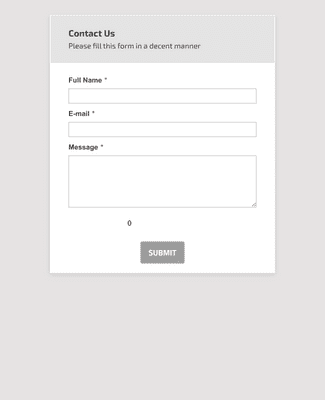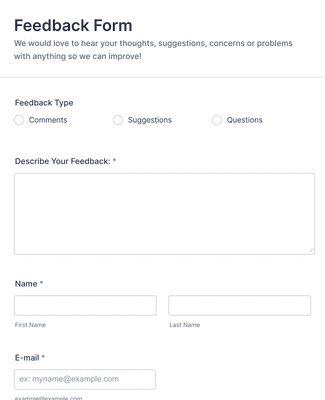Create Next.js Forms
Forget complex coding — embrace the future of data collection with a free Next.js form builder! Build and customize your form with an intuitive drag-and-drop interface, then connect it with your preferred applications. When you’re finished, you can seamlessly embed the form in your website, all without any coding.
Pohjat
Next.js Form Templates
Not sure where to start? Don’t sweat it. Simply choose one of our ready-made templates and customize it in our drag-and-drop form builder in a matter of minutes. Match your branding with custom images, fonts, and colors!
General Inquiry Contact Form

New Customer Registration Form

Palautelomake

Benefits
Design the perfect form
Jotform's robust drag-and-drop Next.js form builder lets you create and customize forms in minutes. We offer hundreds of form fields, valuable widgets, and handy integrations that make it simple to build dynamic forms for your web applications.
Easy to customize
Match your forms to your brand identity by uploading images and videos, changing fonts and colors, adding your own logos, and more. Plus, you can collect e-signatures with Jotform Sign, create custom reports with Report Builder, and much more with our suite of productivity features.
Collect payments online
Increase sales, bookings, and donations by giving customers an easy way to pay online. Integrate online forms with one of our 30+ popular payment processors, such as Square, Stripe, or PayPal. Jotform never charges additional transaction fees, so you’ll pay your usual rate.
Share and embed
You can share your forms with your audience and customers in just a few simple steps. Provide a link to your form on social media sites like Instagram, or send it via email or QR code. For increased visibility, Jotform also provides embed codes to embed your forms directly in your own website!
Track and manage submissions
With Jotform, you can effortlessly track and manage submissions by instantly accessing them on any device. You can also organize submissions using Jotform Tables, and automate tasks when converting them into PDFs or establishing approval workflows with Jotform Workflows.
Suositukset
An amazingly convenient tool
Learn How To Create a Form with Jotform
Discover how to build online forms using Jotform in this quick tutorial. Whether you’re collecting applications, orders, or registrations, you can create your first form from scratch in just a few minutes.

Frequently Asked Questions
All your questions about Jotform — answered. Check out our FAQs for answers to common questions, or contact our support team for further information.
What are Next.js forms?
Next.js is a React framework that gives users the building blocks they need to create web applications. This means that Next.js manages React configuration and provides additional structure, features, and optimizations for web applications.
Forms are useful for web applications because they enable users to collect data and update applications. Next.js forms offer an efficient way to handle form submissions and data mutations. With Jotform, you can create the perfect Next.js forms for all your needs.
How do I build my own form?
With Jotform, you can build your own form in a matter of minutes. Just choose a template from our extensive template directory, or start from scratch. Then, you can design your form with your own logo, fonts, and colors, and connect with handy widgets and integrations. You can even set up autoresponder emails to be sent any time a recipient completes your form.
How do I embed forms in my email or website?
Jotform makes it easy to embed forms without any coding. Though we generally recommend embedding your form in a website rather than an email, you can copy your source code and paste it in an email. You can also follow these same steps to paste the embed code in your website.
Learn how to get the full source code of your form and how to embed a form in your web page.
What are Next.js forms used for?
Next.js forms are primarily used to collect and update data in web applications. They are extremely useful for web developers who want to gather information to manage securely mutating data on the server, redirect users to a different route after a mutation, redirect to any absolute or relative URL, display loading states, handle errors, set cookies, and much more.
Is there a fast way to manage and analyze form data?
Jotform Tables is an all-in-one data workspace that lets you collect, organize, and manage data effortlessly. You can auto-populate your tables with submission data, or import your existing data in CSV or Excel files directly into Jotform Tables. Make sure you assign entries to teammates, track your progress, and customize access settings to control who can view or edit your workspace. Plus, share your tables in one click to collaborate with teammates, colleagues, and clients.
Is coding knowledge required to build Next.js forms with Jotform?
Nope — that’s one of the major perks of Jotform’s intuitive drag-and-drop form builder! You don’t need to know how to code to build custom forms that fit your needs. While advanced users do have the option to make adjustments directly in the HTML code, anyone can create the form they need without any coding knowledge.